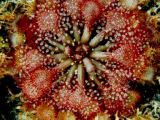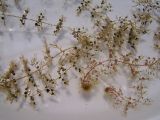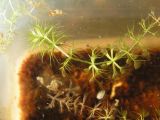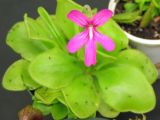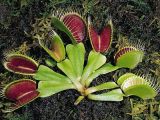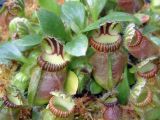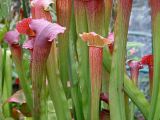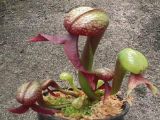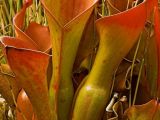Plants make photosynthesis to get all the food they need. And food, for both plants and animals, is represented by three classes of chemicals: sugars, fats and proteins. Sugars and fats are made of carbon, hydrogen and oxygen: these elements are easily extracted from air (carbon dioxide) and water.
But proteins contain nitrogen, and even if the air is made 80 % of nitrogen, this cannot be used by superior plants: only some bacteria can bind this form of nitrogen and plants that make symbiosis with this kind of bacteria (like those from the bean family), never lacking nitrogen.
The rest of the plants must take it from the soil. But some environments are extremely poor in nitrogen, like peat bogs, swamps or slowly flowing waters; also epiphytes plants get little nitrogen.
Some plants living in these environments developed an adaptation for getting nitrogen: they take it from animal proteins. Literally, they kill, digest and absorb nitrogen chemicals from the body of tiny animals they can catch (larger species can even kill rats!). There are over 450 species of carnivorous plants, belonging to 6 families, all endowed with various traps, most secrete digestive juices and some execute slow or quick movements than can be seen by people.
This lifestyle amongst plants is extremely old: the earliest known flowering plant known from the lower Cretaceous (in the middle of the dinosaur era) of China is a relative of the American pitcher plants.
Here are the most known carnivorous plants:
1.Sundews (Drosera) are represented by over 170 species. These are amongst the most widespread carnivorous plants, found all over the world, on all continents (except Antarctica) and even in New Zealand.
They live in swamps, peat bogs and shrubland. The leaves present sensitive tentacles which on their top have a sticky liquid like a water droplet, luring insects. The liquid is rich in sugars. If an insect attracted by the shinny droplets lands on the leaves and touches the tentacles, they glue it and the movements produced in the attempt to escape will bend the tentacles toward the insect, covering it and immobilizing it more tightly.
Eventually, the prey either succumbs to death through exhaustion or through asphyxiation as the mucilage envelops them and clogs their spiracles, within 15 minutes. The tentacles start to secret the digestive juices and in 1-2 days the insect is completely eaten. In that moment, the tentacles are no more chemically excited, and turn back to their initial position, while the rests of the insects are pushed away by a whiff.
Rainbow plants (Byblis), related to mint, and native to western Australia, are very similar to Drosera in their mechanism.
2.Butterworts (Pinguicula) live in wet places in Americas, Europe and northern Asia. These plants use sticky, glandular leaves to lure, trap, and digest insects.
Special cells on the leaves' surface produce a mucilagenous secretion which forms visible droplets across the leaf surface. This wet appearance lures prey in search of water (like in sundews). On contact with an insect, the peduncular glands release additional mucilage from special reservoir cells. The insect will begin to struggle, triggering more glands and encasing itself in mucilage.
Butterworts are usually only able to trap small insects and those with large wing surfaces, but they also digest pollen which lands on their leaf surface. The secretory system can only function a single time, so that a particular area of the leaf surface can only be used to digest insects once.
Shepherds in some European areas (like Carpathians) use butterworts to curdle the milk during cheese processing.
3.Bladderworts (Utricularia and Polypompholyx), related to the butterworts, represent the largest genus of carnivorous plants (over 200 species), even more widespread than sundews. They have bladder-like traps and either aquatic or live on wet soils or are epiphytes (even on Bromeliads). The bladder can be over 5 mm long, trapping from rotifers to nematodes, water fleas and even fish fry, mosquito larvae and new tadpoles. The traps are highly sophisticated.
Special glands eliminate the water from the vesicle, and the trapdoor is maintained closed by the external pressure of the water. The plants secret a sugar rich substance which lure the prey and hardens the trapdoor at the same time.
When prey animals brush against trigger hairs connected to the trapdoor, which opens immediately due to the pressure difference, and the bladder sucks in the prey, along with the water surrounding it. Once the bladder is full of water, the door closes again, the whole process taking only ten to fifteen thousandths of a second.
Going out is impossible, as inner pressure is equal to outer pressure and in 1-3 days, the little animals die of hunger, and are digested. The glands eliminate the water and the digestion is started.
Bladderworts can catch up to 1,000 preys daily (like water fleas). They can consume larger prey such as young tadpoles and mosquito larvae by catching them by the tail, and ingesting them bit by bit. Terrestrial species have smaller traps and catch smaller preys.
4.Waterweel plant (Aldrovanda) is related to the sundews. The only species, found in Europe, Asia, Africa and Australia, lives in the water. The traps are arranged in whorls around a central, free-floating stem, hence the common name. The traps consist of two lobes which fold together to form a snap-trap like an open book. These traps, which are twisted so that the trap openings point outward, are lined on the inside by a fine coating of trigger hairs, snapping shut in response to contact with aquatic invertebrates and trapping them.
The closing of this trap takes a mere 0.01-0.02 seconds, being one of the fastest examples of plant movement in the kingdom. This trapping is only possible in warm conditions (20 ?C). Each trap is surrounded by between four and six 6-8 mm long bristles which prevent triggering of traps by debris in the water.
5.The Venus flytrap (Dionaea muscicapula) lives in bogs in North and South Carolina (southeastern US). It catches and digests animal prey (mostly insects and arachnids) with the trap formed by the terminal portion of each of the plant's leaves. The mechanism by which the trap snaps shut involves a complex interaction between elasticity, turgor and growth. The main rib forms a hinge to which two lobes of the leaf edged by "teeth" are fixed. There are three sensitive hairs on the lobes triggering the mechanism.
In the open, untripped state, the two spiny lobes are convex (bent outwards), but in the closed state, the lobes are concave (forming a cavity). It is the rapid flipping of this bistable state that closes the trap, in a fraction of second.
When the trigger hairs are stimulated, an action potential is generated, which propagates across the lobes and stimulates cells in the lobes and in the midrib between them. If a hair is touched, the trap is triggered, but only a second touch, of the same hair or another, closes the trap. The two stages closing mechanism avoid the accidental triggering of the trap, like from a rain drop. The trapped prey keeps on stimulating the inner surface of the lobes, and this induces a further growth response that forces the edges of the lobes together, eventually sealing the trap hermetically and forming a 'stomach' in which digestion occurs. Between the trap's lobes remain enough space, so that small insects can escape. Instead, larger prey will stimulate further the trap, which will gradually close further in a few hours, crushing the trap.
Digestion takes about 10 days; then the trap reopens, and is ready for reuse; even though the trap rarely catches more than three insects in its lifetime. The plant can hunt even froglets.
6.Pitcher plants (Nepenthes) possess perhaps the most spectacular traps, even if amongst the least sophisticated functionally. These plants grow from Madagascar and southeastern Asia to northeastern Australia.
The 117 species are also called "Monkey cups" as monkeys have been seen drinking rainwater from these plants. Many are epiphytes.
The leaf continues with a tendril than ends with the pitcher like trap. The trap contains a fluid of the plant's own production, which may be watery or syrupy and is used to drown the prey. The lower part of the trap contains glands which absorb nutrients from captured prey.
Along the upper inside part of the trap there is a slick waxy coating which makes the escape of its prey nearly impossible. Surrounding the entrance to the trap is a structure called the peristome (the "lip") which is slippery and often quite colorful, attracting prey but offering an unsure footing. Above the peristome there is a lid (the operculum): in many species this keeps rain from diluting the fluid within the pitcher, the underside of which may contain nectar glands which attract prey.
The trap can be 50 cm (20 inch) long and 15 cm (6 inch) wide. The plants usually catch insects, but larger species can even trap rats, song birds or lizards. Due to their extremely ornamental traps, many species of Nepenthes are cultivated in greenhouses. The digestive enzymes of Nepenthes can digest even the chitin of the insects, rich in nitrogen, which most animals cannot digest.
7.Mocassin plant or Western Australian pitcher plant (Cephalotus) lives in southwest Australia. It has pitchers, too, but shorter, with a wider mouth, and placed more gathered.
8.North American pitcher plants (Sarracenia) have evolved funnels to trap insects. The funnels can be 1 m (3.3 ft) long. They live in acid swamps in Eastern US and southern Canada. The insects are attracted by a nectar-like secretion on the lip of pitchers, as well as a combination of color and scent.
Slippery footing at the pitchers' rim, aided in at least one species by a narcotic drug lacing the nectar, causes insects to get dizzy and fall inside, where they drown and are digested by the plant as a nutrient source, through digestive juices secreted by minute glands from the inner wall of the pitcher.. The hairs on the walls of the trap impede the insects to climb back as they are oriented downward. The mouth of the funnel is guarded by an operculum which attracts the prey.
Still, some insects manage to survive, and the the larvae of the mosquito Wycomyia smithii actually live in the pitcher of Sarracenia purpurea, adults entering and getting out without problems. The spider Misumenops nepenthicola is a frequent dweller of the pitchers.
Very similar are also sun pitchers (Heliamphora), living only in the tepui mountains of the southern Venezuela and Guyana. Like the next species, they do not produce their own digestive enzymes.
9.Cobra plant or California pitcher plant (Darlingtonia) found in northern California and Oregon, lives in bogs and seeps with running water. Its tubular leaves look like a rearing cobra with a forked leaf. Unlike some other pitcher-plants, its leaves don't produce any digestive enzymes. The cells that absorb nutrients from the inside of the pitcher are the same as those on the roots that absorb soil nutrients. Instead, the California pitcher plant relies on symbiotic bacteria and protozoa to break down the captured insects into simpler chemicals.
In addition to the use of lubricating secretions and downward-pointing hairs common to all pitcher plants to force their prey into the trap, this species carefully hides the tiny exit hole from trapped insects by curling it underneath and offering multiple translucent false exits.
Upon trying many times to leave via the false exits, the insect will tire and fall down into the trap. The slippery walls and hairs prevent the trapped prey from escaping. Parrot Pitcher Plant, Sarracenia psittacina, uses this technique, too.
10.Portuguese sundew (Drosophyllum lusitanicum) is native to Portugal, Spain and Morocco, and is one of the few carnivorous plants to grow in dry, alkaline soil. The plant has a distinct sweet aroma, which attracts the insects it preys upon. Insects are caught by the mucilage secreted by the stalked glands on the leaves.
There are also carnivorous plants amongst bromeliads (pineapple family) and other groups, but with less spectacular traps. Interesting is also the case of the corkscrew plants (Genlisea) from Africa, Brazil and Madagascar. These terrestrials or semi-aquatic are unique in the plant kingdom for specializing in protozoa and for attracting its prey chemically. They have very unusual underground traps: a pair of thin tubes joined in an inverted 'V' shape, with spiral grooves down their lengths that allow the entrance of soil-borne invertebrates. The grooves are lined with inward-pointing sticky (due to the secretion of glands) hairs that prevent the prey from escaping, and which force the prey items to move towards the centre of the tube. From there, prey is ferried toward the apex of the 'V', where it is digested.
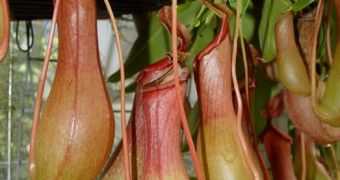
 14 DAY TRIAL //
14 DAY TRIAL // 
